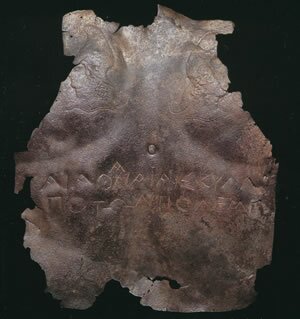Battle of Eurymedon - 466 B.C.
The river Eurymedon, where the Athenian admiral Kimon defeated the Persians in 466 in a double battle. During the day, he defeated the Persian navy at the estuary of the the Eurymedon, and during the night, he unexpectedly attacked the camp of his enemies. At the Persian court, the news of the defeat created great unrest, and king Xerxes was murdered. On the west bank was the town of Aspendus.
The Delian league launched a campaign against the Persians in Asia Minor in order to secure it's possesions in the Aegean sea from possible Persian aggresion. The Athenian general Kimon led 250 Athenian ships against the Persians in Asia Minor.According to Diodorus the 250 ships were joined by a 100 more from Ionia and other members of the Delian league. The Greek cities near the coast of Caria surrendered without resistance but the bilangual cities resisted and Kimon had to besiege them. The city that resisted the most was the Greek-speaking Fasilida. According to Plutarch the soldiers of Chios, that followed the Athenians, long-standing friends of Fasilides, threw arrows with written messages inside the walls calling their friends to submit. The inhabitants of the city accepted and after offering 10 talanta (ancient money) to the allies,they followed the Athenians in their campaign and joined the Delian League. Afterwards Kimon managed to subdue the majority of Lycia cities, which joined the Delian League.
The Battle

Artifact: A Southern Italian Greek bronze 'cuirass' worn on the back. The inscription says 'To Athena, spoils from the enemy'. It has been dated between 400 - 370 B.C. |
Afterwards Kimon directed his fleet against the Persian navy, near Eurymedon river. Tithrafstes, as Persian naval commander was an illegitimate son of king Xerxes. Supreme commander of the ground forces was Ferendatis, but according to Plutarch the most influential leader was Ariomandes. Plutarch states how Ariomandes with the majority of Persian naval force, camped near Eurymedon River and waited another 80 Phoenician ships from Cyprus, while the Persian ground force was nearby. Kimon attacked Ariomande's fleet before the reinforcements arrived. At the beginning the Persians tried to avoid the battle, but finally gave up. The Persian fleet consisted of 350 ships, according to Ephoros, or 500 ships according to Fanodemos. Plutarch mentions both reports. Finally the Athenians won the seafight and captured plenty of the Persian ships. The remaining Persian naval forces entered the Persian camp and united with the Persian ground force. But soon Kimon attacked the Persian camp, after exporting his troops from the ships. A fierce battle followed with both sides suffering major casualties. The Athenians finally won and many Persians were captured. After succeeding victory, Kimon led his forces against the 80 Phoenician reinforcement ships, the same ones that Ariomandes waited. These ships have already fled to the island of Hydra, without a single knowledge of the Eurymedon events. Kimon took them by surprise and destroyed the most of them.
The battle guaranteed the security insurance of the Athenian - led Delian League. The Persian fleet was no more a real threat to the Aegean Sea. A year after the battle, Kimon attacked the remaining Persian forces in Thracian peninsula. After the victory he succeeded there, the Athenian general secured the Aegean sea definitely. The Athenian-led Delian League was immunised and the Athenians had a free hand in inner Greek policies. This situation lasted until the destruction of the Athenian expeditionary force in Egypt, possibly between 460 BC - 456 BC, an event that contributed to the reemergence of Persia as a major naval power in eastern Mediterranean.
References:
http://www.mkg-hamburg.de/mkg.php/en/sammlungen/antike/~P7/

